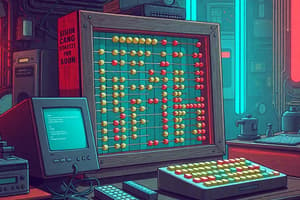Podcast
Questions and Answers
What was the processor used in the Apple-1 computer?
What was the processor used in the Apple-1 computer?
- Zilog Z80
- Intel 8080
- Motorola 68000
- MOS Technology 6502 processor running at 1.023 MHz (correct)
Which of the following is NOT an advantage of 5th generation computers?
Which of the following is NOT an advantage of 5th generation computers?
- Increased risk of cybercrimes (correct)
- Security
- Reliability
- No major heating issues
What was a significant development in the 5th generation of computers?
What was a significant development in the 5th generation of computers?
- The transition from VLSI to ULSI technology (correct)
- The introduction of vacuum tubes
- The use of mechanical relays
- The development of punch card systems
Which programming languages are commonly used in 5th generation computers?
Which programming languages are commonly used in 5th generation computers?
What was a notable disadvantage of the Apple-1 computer?
What was a notable disadvantage of the Apple-1 computer?
Which of the following is an example of a 5th generation computer?
Which of the following is an example of a 5th generation computer?
Which of the following was a key advantage of third-generation computers utilizing integrated circuits?
Which of the following was a key advantage of third-generation computers utilizing integrated circuits?
What was a major disadvantage associated with the manufacturing of third-generation integrated circuit chips?
What was a major disadvantage associated with the manufacturing of third-generation integrated circuit chips?
Which of the following programming languages was utilized in third-generation computers?
Which of the following programming languages was utilized in third-generation computers?
What was a significant transition that occurred with the IBM 360 series during the third generation of computers?
What was a significant transition that occurred with the IBM 360 series during the third generation of computers?
Which of the following statements accurately describes the storage capabilities of third-generation computers?
Which of the following statements accurately describes the storage capabilities of third-generation computers?
What was a key characteristic of fourth-generation computers that utilized microprocessors and VLSI technology?
What was a key characteristic of fourth-generation computers that utilized microprocessors and VLSI technology?
What was the primary advantage of the von Neumann architecture in early computer design?
What was the primary advantage of the von Neumann architecture in early computer design?
What was a potential disadvantage of the von Neumann architecture in terms of memory access?
What was a potential disadvantage of the von Neumann architecture in terms of memory access?
What was a significant contribution of John von Neumann in the context of computer memory?
What was a significant contribution of John von Neumann in the context of computer memory?
How did the von Neumann architecture influence the manufacturing of early computers?
How did the von Neumann architecture influence the manufacturing of early computers?
What was a significant historical impact of the von Neumann architecture?
What was a significant historical impact of the von Neumann architecture?
What was a potential limitation of the von Neumann architecture in terms of storage capacity?
What was a potential limitation of the von Neumann architecture in terms of storage capacity?
Flashcards are hidden until you start studying
Study Notes
Computer System Components
- The Central Processing Unit (CPU) is responsible for data processing and exchanging data with memory.
- Memory holds data and programs for access by the CPU during processing.
- Output devices display the results of data processing to the user.
Functions of a Computer System
- Processing data, which may take various forms, and storing it temporarily or permanently.
- Moving data for processing and communication.
- Controlling the performance of functional units and managing computer resources.
Von Neumann Architecture
- Developed by John von Neumann, a mathematician and physicist.
- Based on the stored program concept.
- Major guidelines: memory holds both programs and data.
History of Computers
4th Generation (Microprocessor)
- APPLE-1 was created by Steve Wozniak, Steve Jobs, and Ron Wayne.
- Processor: MOS Technology 6502 processor running at 1.023 MHz.
- Memory: 4k RAM, expandable to 8k, 65k.
- OS: BASIC.
5th Generation (AI)
- Known as modern computers, still in development, and based on artificial intelligence.
- VLSI technology became ULSI, producing microprocessor chips with 10 million electronic components.
- Characteristics: high computing power, parallel processing, and development of AI software.
- Programming languages: C, C++, Java, .Net, and more.
Advantages and Disadvantages of 5th Generation Computers
- Advantages: reliability, security, convenience, operability, and various features and sizes.
- Disadvantages: exposure to cybercrimes, privacy issues, leak of confidential information, and human overdependence.
3rd Generation (Integrated Circuits)
- Advantages: higher storage capacity, speed, efficiency, and low maintenance cost.
- Disadvantages: integrated circuits were difficult to repair, and required air conditioning.
- Examples: PDP, Honeywell-6000, IBM-360 series.
IBM 360
- Represented the transition to the 3rd Generation of mainframe computers.
- Developed for high-speed data processing for scientific tasks and data processing.
- Supported both scientific computing and data processing.
Studying That Suits You
Use AI to generate personalized quizzes and flashcards to suit your learning preferences.



